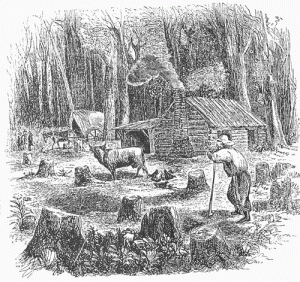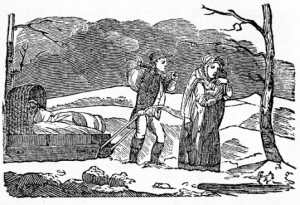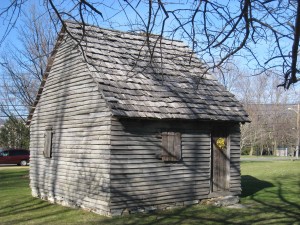Life for Early Lenox Settlers
We have not yet found first person accounts of what greeted the early settlers (say 1750’s) but we can make some educated guesses based on accounts from similar settlements. The Berkshires, particularly in the Lenox area, had been used more for hunting than cultivation by the Indians, so there would not, as there had been in the eastern part of the state, have been any prior clearing. Most land would have been heavily wooded with original growth forest and probably thick with underbrush. Without clearing, food was limited to hunting and gathering.
Clearing Trees
 Initial clearing was generally done by girdling the trees, felling them and letting the stumps die off. While the land was still full of stumps, it would have been difficult to grow wheat or other European crops. Probably, therefore, initial agriculture would have been to grow native plants such as corn, beans and pumpkins and raise livestock that could live by foraging – such as pigs and goats. This would have been so much work that the settler probably would have cleared a couple of acres one year, then a few more the next. Obviously meadowland or previously cleared land was at a premium. Reportedly, by 1800, the land was bare of trees!
Initial clearing was generally done by girdling the trees, felling them and letting the stumps die off. While the land was still full of stumps, it would have been difficult to grow wheat or other European crops. Probably, therefore, initial agriculture would have been to grow native plants such as corn, beans and pumpkins and raise livestock that could live by foraging – such as pigs and goats. This would have been so much work that the settler probably would have cleared a couple of acres one year, then a few more the next. Obviously meadowland or previously cleared land was at a premium. Reportedly, by 1800, the land was bare of trees!
Timber was potentially a cash crop. It could be sold for planing into planks, for ship masts, for pitch or for fuel. However, it’s not clear that there was, in the earliest days, a way to get raw logs to market. Felled trees may have just been used to build rudimentary log shelters and for fuel. One source* reports it took an acre of timber to heat a family for a year!
Travel and Transportation of Goods

Accounts of initial settlement of Sheffield and Pittsfield report individuals coming to clear their lots on paths that could barely accommodate one person or horse single file. In that condition any goods (from farm tools, to nails, to blankets and clothing) would have to have been carried in on the back of a horse or a man. Enough improvement in roads to accommodate an ox cart would have allowed settlers to bring in goods made nearby such as nails, planed planks, tools and ground corn. Goods manufactured outside of the rural Berkshires – such as bricks, cloth, guns, glass, books and paper – would have to have been moved from a port city; perhaps up the Hudson and then over and up from the road through Great Barrington?
It is not yet clear what roads might have been available. Early plot plans for Mt. Epraim/Yokuntown show some county roads (presumably these could have accommodated carts or other means of hauling goods), but we have not yet found a date for when these roads would have been cleared. The county roads (whenever they were put in) appear to have connected Sheffield, Great Barrington, Stockbridge and Poontusuck (Pittsfield) – much as Route 7 does today.
Early Farming and Industry
The settlers might or might not have had oxen or other work animals. Horses were generally a luxury for the wealthy and many farmers would have had to borrow (in return for some other bartered favor or crops) the use of farm animals to haul goods and break the soil. Cattle and sheep would become important sources for both sustenance and sale. But in the early days, foraging animals such as goats or pigs would have been most common. They probably would have been driven in from of the walking or riding settlers and allowed to wander freely (with notched ears or other markers of ownership).
Setting up mills for planing logs, forging iron, and grinding corn and other grains would have been a priority. Maps from the 1790’s show several mills in Lenox. Until mills became available, settlers would have had to transport raw materials to Stockbridge or other towns settled earlier to have them worked.

Initial houses would have been windowless and rudimentary, perhaps with only one room initially with a fire place that would have to double for light, heat and cooking. There may have been a loft for sleeping and generally a dirt floor.
Settlers would have upgraded to frame houses with stone foundations as soon as they could, but often the original log house would stand into the 19th century.
As the children and grandchildren of early settlers of Westfield, Sheffield and western Connecticut, the Lenox settlers would have known what they had to do to make corn meal, hunt for game, find wild berries and herbs, and slaughter and smoke their meat. Their parents or grandparents would have created similar shelters for the first phase of their housing. They probably would have had a treasured metal pot and metal crane for cooking, melting ice, etc.
Settlers would upgrade housing, crops and livestock as quickly as money or more readily available resources permitted.
See
Daily Life in Colonial New England, Claudia Durst Johnson, Greenwood Press, Daily Life History Series
Daily Life in the Massachusetts Bay Colony, George Francis Dow, Arno Press, A New York Times Company, New York, 1977
Early Life in Sheffield Berkshire County, Massachusetts, A Portrait of Its Ordinary People from Settlement to 1860, James R. Miller, Sheffield Historical Society 2002
The History of Pittsfield 1734-1800, J.E.A. Smith, Lee and Shepherd, 1869
